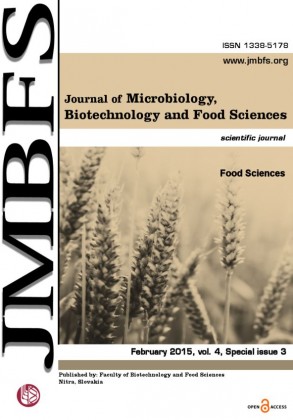ATTEMPT TO REDUCE ACRYLAMIDE CONTENT IN ROASTED CHICORY
DOI:
https://doi.org/10.15414/jmbfs.2015.4.special3.188-191Keywords:
Chicory root, roasting, acrylamideAbstract
The aim of this study was to reduce the formation of acrylamide during roasting of chicory roots by soaking the fresh roots in a solutionof calcium chloride, by the use of different temperature and time of roasting of dried roots, as well as by the addition of the enzyme
(asparaginase) during roasting of dried roots.
It was shown, that with increasing roasting temperature of chicory roots from 100 - 175 ° C the acrylamide content also increased, while
at a temperature of 210 ° C the growth was inhibited. Increasing roasting time from 10 - 25 minutes resulted in an increased acrylamide
content. Soaking the roots in the CaCl2 solution for 20 minutes reduced the formation of acrylamide during the roasting approximately
by 40%, similarly as the application of asparaginase to the dried roots during the roasting process.
Downloads
Download data is not yet available.
Downloads
Published
2015-02-02
How to Cite
ZiÄć, G., Gambuś, H., Berski, W., Litwinek, D., Wyworcka-Gurgul, A., & Mickowska, B. (2015). ATTEMPT TO REDUCE ACRYLAMIDE CONTENT IN ROASTED CHICORY. Journal of Microbiology, Biotechnology and Food Sciences, 4(special issue 3 (Food Sciences), 188–191. https://doi.org/10.15414/jmbfs.2015.4.special3.188-191
Issue
Section
Food Sciences
License
Copyright (c) 2015 Gabriela Zięć, Halina Gambuś, Wiktor Berski, Dorota Litwinek, Anna Wyworcka-Gurgul, Barbara Mickowska

This work is licensed under a Creative Commons Attribution 4.0 International License.
All papers published in the Journal of Microbiology, Biotechnology and Food Sciences are published under a CC-BY licence (CC-BY 4.0). Published materials can be shared (copy and redistribute the material in any medium or format) and adapted (remix, transform, and build upon the material for any purpose, even commercially) with specifying the author(s).





